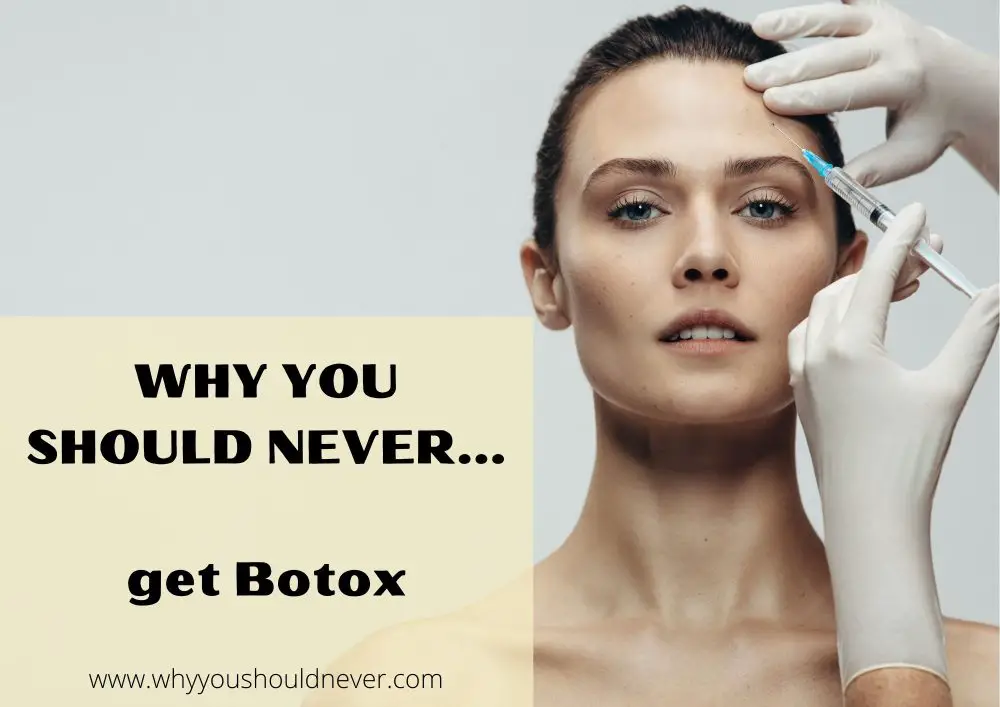![]()
Why You Should Never Get Botox
We’re all familiar with the term Botox. Made popular back in the 90’s by rich, vain celebrities, the once controversial treatment is now the most popular cosmetic procedure in the US.
NEED TO KNOW
What is Botox?
What does Botox stand for?
Botox is the acronym given to botulinum toxin type A, a neurotoxin protein.
What is Botox used for?
It’s primarily a treatment to reduce wrinkles on the face, but is also used as a way to treat underarm sweating.
Each treatment lasts up to four months before another is required.
How does Botox work?
Botox is injected into specific muscles in the face, such as the forehead, between the eyebrows and around the eyes, to paralyze or relax them.
When was Botox invented, and by whom?
Alan Scott, an ophthalmologist, invented the treatment quite by accident back in the 1970s, when he was trying to treat a completely unrelated condition – double vision.
The procedure didn’t reach the open market until 1989.
Now, you’re probably thinking, hey, a treatment that lets you reverse the signs of aging is an amazing opportunity to reduce the appearance of wrinkles. Gone will be the days of spending hours on your makeup, trying to get it just right in order to cover those unsightly lines on your face.
Unfortunately, this anti-aging treatment comes at a price – both in its cost and the potential side effects.
In the rest of this article, we’ll discuss some of the reasons why getting Botox is a no-no, and what alternatives exist for keeping your skin looking youthful.
Toxic chemicals
As mentioned above, Botox is a neurotoxin, and the botulinum toxin itself causes botulism, an illness that paralyzes muscles.
Though the amounts used in the Botox procedure are said to be minimal and thus not life-threatening, you’re still injecting poison into your body.
The side effects
There are a number of potential side effects – some dangerous – that many patients have experienced after getting this cosmetic treatment. These include:
-
headaches
-
pain and swelling in the injection areas
-
fever or flu-like symptoms
-
dryness in the eyes, due to its effect on your tear ducts
-
drooping eyelids
Less commonly seen effects can be double vision, difficulty swallowing food, and slurred speech.
It’s expensive
Although the price has seen a drastic reduction over the years, Botox is still a costly procedure. You could be paying upwards of $300 per treatment – much higher if the area to which the Botox will be applied is large.
Factor in that the effects only last up to four months, so you’ll need to cough up this amount 3 times a year, if you’re to maintain your new look.
It makes you look plastic
You know who the singer Cher is, right? Of course you do. Well, she’s also a fan of Botox… Need I say more?
The truth is, continued use will give you a plastic, somewhat robotic look, and you’ll start to look like everyone else who’s had Botox.
Your facial expressions will be limited
Botox restricts the muscles in your face, which can limit how much you’re able to express yourself.
For some people, this could be a good thing: they might not want their facial expressions changing every time something happens. They might not mind looking stoic all the time.
For others, having the exact same expression, whether you’re receiving good news or bad, will get real old, real quick.
It might age your skin
According to one doctor in this Vogue article, Botox used over time will start to flatten and weaken your facial muscles, making your skin appear looser.
This is especially an issue for younger people getting what is known as “preventative Botox”.
What is preventative Botox?
It’s when Botox is given to people in their 20’s who don’t yet have wrinkles but want to prevent them from ever forming.
This can lead to overuse of Botox – since it’s more effective the earlier you start using it – which could cause your skin to age prematurely.
You could get addicted
It can be very easy to get addicted to your new, youthful look, so much that skipping even one treatment will make you panic.
Thus, you might be tempted to get Botox top-ups every 4 weeks, which many do, as the initial effects start to fade.
And then, if you’re not careful, this could lead you to get more invasive, more permanent surgery, like a face-lift.
What are the alternatives to getting Botox?
If you’re looking for safer, less expensive ways to keep yourself looking youthful, you should consider:
-
anti-wrinkle cream
-
drinking lots of water
-
eating an organic, mostly vegan diet
-
staying out of the sun, and using sunscreen whenever you’re in it
-
don’t wear a lot of makeup
Conclusion
Everyone gets older, and although wrinkles might seem unpleasant, they’re just a natural part of life.
The reality is, you might be able to reverse the aging look of your face, but the rest of your body will show your age anyway.
